The multi-modal biometric cabin sensors market is projected to grow from USD 1,786.7 million in 2025 to approximately USD 2,554.4 million by 2035, recording an absolute increase of USD 767.7 million over the forecast period. This translates into a total growth of 43.0%, with the market forecast to expand at a compound annual growth rate (CAGR) of 3.6% between 2025 and 2035. The overall market size is expected to grow by nearly 1.4X during the same period, supported by increasing demand for advanced biometric authentication systems, growing security requirements in vehicles and access control systems, and rising adoption of multi-modal sensing technologies in critical security applications across global automotive and industrial infrastructure.
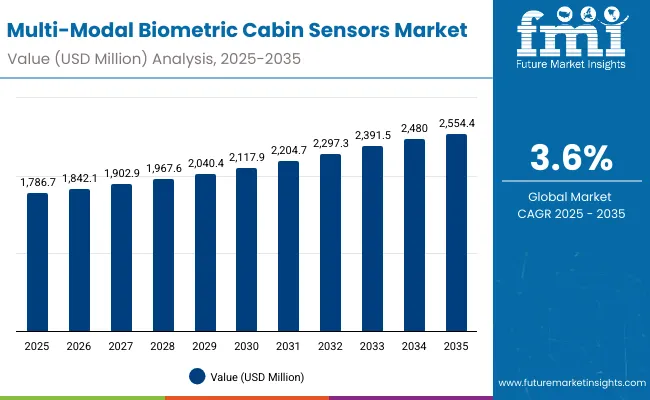
Multi-Modal Biometric Cabin Sensors Market Key Takeaways
| Metric | Value |
|---|---|
| Estimated Value in (2025E) | USD 1,786.7 million |
| Forecast Value in (2035F) | USD 2,554.4 million |
| Forecast CAGR (2025 to 2035) | 3.6% |
Between 2025 and 2030, the multi-modal biometric cabin sensors market is projected to expand from USD 1,786.7 million to USD 2,117.9 million, resulting in a value increase of USD 331.2 million, which represents 43.1% of the total forecast growth for the decade. This phase of development will be shaped by increasing automotive safety regulations, rising adoption of biometric authentication in vehicles, and growing utilization in smart access control and security applications. Equipment manufacturers and sensor suppliers are expanding their production capabilities to address the growing preference for advanced biometric solutions in critical security operations and identity verification applications.
From 2030 to 2035, the market is forecast to grow from USD 2,117.9 million to USD 2,554.4 million, adding another USD 436.5 million, which constitutes 56.9% of the overall ten-year expansion. This period is expected to be characterized by the expansion of advanced biometric technologies, the integration of artificial intelligence and machine learning capabilities, and the development of specialized sensor solutions for emerging security applications. The growing emphasis on cybersecurity and identity protection will drive demand for intelligent biometric systems with enhanced accuracy and multi-factor authentication capabilities.
Between 2020 and 2024, the multi-modal biometric cabin sensors market experienced robust growth, driven by increasing security concerns and growing recognition of biometric authentication's importance in maintaining secure access control systems. The market developed as security providers recognized the potential for multi-modal sensors to enhance identification accuracy while meeting stringent security requirements. Technological advancement in sensor fusion and biometric algorithms began emphasizing the critical importance of maintaining identity verification while reducing false positives and improving authentication reliability.
Market expansion is being supported by the increasing global demand for advanced security solutions and the corresponding shift toward biometric technologies that can provide superior authentication accuracy while meeting stringent security requirements for critical access control applications. Modern automotive manufacturers and security system providers are increasingly focused on incorporating multi-modal biometric sensors to enhance security reliability while satisfying demands for seamless user experience and proven performance in demanding operational environments. Multi-modal biometric cabin sensors' proven ability to deliver superior identification accuracy, operational reliability, and fraud prevention capabilities makes them essential components for advanced security operations and critical authentication applications.
The growing emphasis on automotive safety and smart vehicle technologies is driving demand for intelligent biometric systems that can support distinctive security characteristics and mission-critical applications across vehicle access, driver monitoring, and passenger identification categories. Security provider preference for solutions that combine authentication excellence with proven reliability credentials is creating opportunities for innovative biometric implementations in both traditional and emerging security applications. The rising influence of regulatory compliance and cybersecurity protocols is also contributing to increased adoption of multi-modal authentication systems that can provide real-time identity verification and enhanced security monitoring.
The market is segmented by measurement principle, interface, form factor, and end-use sector. By measurement principle, the market is divided into optical/imaging, electromagnetic/inductive, acoustic/ultrasonic, and other principles. Based on interface, the market is categorized into ethernet/fieldbus, serial/discrete, I2C line/proprietary, and analog. By form factor, the market is divided into fixed, portable, and embedded/board-level. Based on end-use sector, the market is segmented into electronics/semiconductor, F&B/packaging, industrial process, and others.
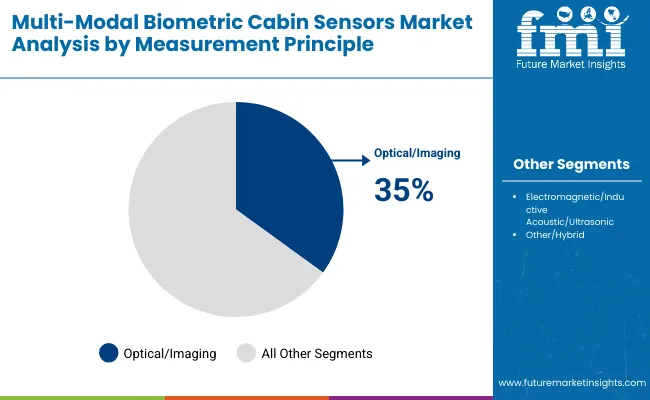
The optical/imaging segment is projected to account for 35.0% of the multi-modal biometric cabin sensors market in 2025, reaffirming its position as the leading measurement principle category. Automotive manufacturers and security system designers increasingly utilize optical/imaging sensors for their superior resolution capabilities, advanced image processing features, and ease of integration in complex biometric systems across diverse security applications. This sensor type's proven design directly addresses security requirements for reliable facial recognition and efficient operation in variable lighting conditions.
This segment forms the foundation of modern biometric authentication applications, as it represents the configuration with the greatest versatility and established compatibility across multiple identification systems. Security provider investments in optical technology optimization and image processing enhancement continue to strengthen adoption among system integrators. With security facilities prioritizing authentication accuracy and consistent performance characteristics, optical/imaging sensors align with both reliability objectives and user experience requirements, making them the central component of comprehensive biometric authentication strategies.
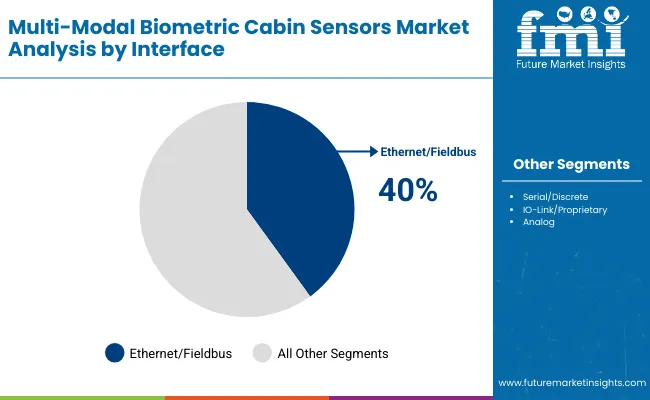
Ethernet/Fieldbus applications represent the dominant segment of multi-modal biometric cabin sensors interface demand in 2025, accounting for 40.0% market share, underscoring their critical role as essential components for industrial communication operations. System integrators prefer ethernet/fieldbus connectivity for their operational reliability, data transmission capacity, and ability to support both standard operations and specialized applications while offering proven effectiveness in demanding industrial environments. Positioned as essential components for industrial connectivity, ethernet/fieldbus interfaces offer both communication capability and integration advantages.
The segment is supported by continuous growth in industrial automation programs and the growing availability of specialized connectivity variants that enable system differentiation and operational effectiveness at the industrial level. Additionally, automation providers are investing in advanced communication technologies to support real-time data transmission and operational accessibility. As industrial connectivity continues to gain priority and providers seek reliable solutions, ethernet/fieldbus applications will continue to dominate the market landscape while supporting operational excellence and system integration strategies.
The multi-modal biometric cabin sensors market is advancing steadily due to increasing security preference for biometric authentication systems and growing demand for multi-factor identification that emphasizes reliable verification across automotive and access control applications. However, the market faces challenges, including high development costs due to advanced sensor fusion requirements, technical complexity from multi-modal integration needs, and competition from single-mode biometric solutions. Innovation in AI-powered sensor systems and privacy protection integration continues to influence market development and expansion patterns.
Expansion of Automotive Security Applications
The growing adoption of multi-modal biometric cabin sensors in advanced vehicle security systems and automated authentication applications is enabling automotive manufacturers to develop vehicles that provide distinctive security capabilities while commanding premium positioning and enhanced safety characteristics. Automated security applications provide superior operational differentiation while allowing more sophisticated vehicle development across various automotive categories and safety segments. Automotive manufacturers are increasingly recognizing the competitive advantages of biometric integration for advanced security development and vehicle automation penetration.
Integration of AI and Machine Learning Technologies
Modern sensor manufacturers are incorporating artificial intelligence, deep learning algorithms, and behavioral analytics capabilities to enhance sensor performance, improve identification accuracy, and meet security demands for intelligent authentication solutions. These technologies enhance operational efficiency while enabling new applications, including adaptive learning and smart security systems for sensors. Advanced technology integration also allows suppliers to support premium market positioning and security trust building beyond traditional sensor supply relationships.
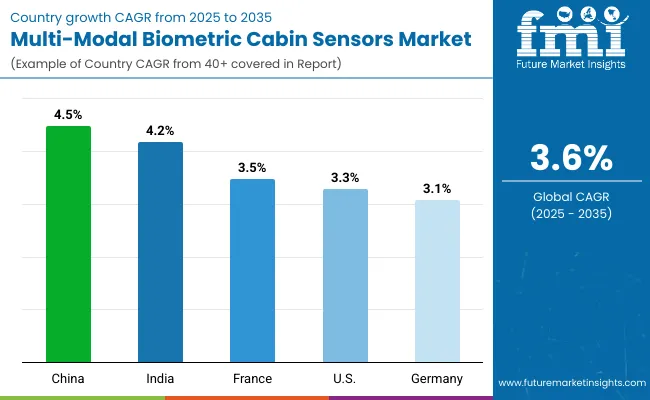
| Country | CAGR (2025 to 2035) |
|---|---|
| China | 4.5% |
| India | 4.2% |
| France | 3.5% |
| USA | 3.3% |
| Germany | 3.1% |
| UK | 3.4% |
| Japan | 3.2% |
The multi-modal biometric cabin sensors market is experiencing steady growth globally, with China leading at a 4.5% CAGR through 2035, driven by the expanding automotive sector, growing security system adoption, and increasing biometric infrastructure development across industrial facilities. India follows at 4.2%, supported by rapid digitalization, rising automotive investments, and increasing demand for security solutions in emerging technology sectors.
The USA shows growth at 3.3%, emphasizing advanced automotive applications and security technology requirements. France records 3.5%, focusing on automotive innovation excellence and security system modernization. Germany demonstrates 3.1% growth, prioritizing precision automotive technology and advanced sensor integration. The UK exhibits 3.4% growth, supported by automotive security capabilities and biometric technology expertise. Japan shows 3.2% growth, emphasizing precision sensor manufacturing and technological innovation.
The report covers an in-depth analysis of 40+ countries; seven top-performing countries are highlighted below.
Revenue from multi-modal biometric cabin sensors in China is projected to exhibit robust growth with a CAGR of 4.5% through 2035, driven by the rapidly expanding automotive sector and increasing security system adoption across manufacturing facilities seeking advanced biometric solutions. The country's growing automotive infrastructure and strategic security technology development are creating substantial demand for biometric sensors in both traditional and advanced automotive applications. Major sensor manufacturers and automotive suppliers are establishing comprehensive production and distribution capabilities to serve both domestic security requirements and export markets.
Revenue from multi-modal biometric cabin sensors in India is expanding at a CAGR of 4.2%, supported by rapid digitalization, increasing automotive facility investments, and growing focus on security infrastructure development requiring biometric solutions. The country's developing automotive sector and expanding digital infrastructure are driving demand for sensor systems across both traditional and modern security applications. International sensor companies and domestic manufacturers are establishing comprehensive distribution and production capabilities to address growing market demand for reliable biometric authentication.
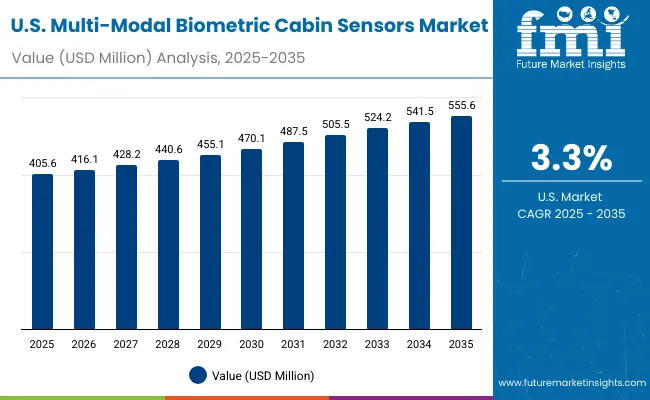
Revenue from multi-modal biometric cabin sensors in the United States is projected to grow at a CAGR of 3.3% through 2035, driven by the country's advanced automotive capabilities, security technology requirements, and continued focus on biometric solutions for critical applications. The USA's sophisticated automotive infrastructure and willingness to invest in sensor systems are creating substantial demand for both standard and specialized biometric variants. Leading automotive companies and technology suppliers are establishing comprehensive sourcing strategies to serve both automotive operations and specialized security markets.
Revenue from multi-modal biometric cabin sensors in France is projected to grow at a CAGR of 3.5% through 2035, supported by the country's advanced automotive innovation industry, vehicle security modernization sector, and established tradition of automotive excellence requiring high-quality sensor solutions. French automotive providers and vehicle manufacturers consistently demand superior biometric systems that meet exacting quality standards for both domestic operations and international automotive markets. The country's position as an automotive technology leader continues to drive innovation in sensor applications and quality standards.
Revenue from multi-modal biometric cabin sensors in Germany is projected to grow at a CAGR of 3.1% through 2035, supported by the country's precision automotive technology programs, expanding vehicle capabilities, and focus on advanced automotive infrastructure requiring sensor solutions. German automotive facilities prioritize operational effectiveness, technology reliability, and vehicle capability enhancement, making biometric sensors essential components for both domestic operations and regional automotive applications. The country's comprehensive automotive development programs and strategic emphasis support continued sensor market development.
Revenue from multi-modal biometric cabin sensors in the UK is projected to grow at a CAGR of 3.4% through 2035, supported by the country's advanced automotive industry, expertise in security technology, and established automotive tradition requiring high-quality sensor solutions. British automotive organizations' focus on operational excellence and proven technologies creates steady demand for reliable sensor systems and specialized variants. The country's attention to technology quality and operational effectiveness drives consistent adoption across both traditional and specialized automotive applications.
Revenue from multi-modal biometric cabin sensors in Japan is projected to grow at a CAGR of 3.2% through 2035, supported by the country's advanced automotive capabilities, precision sensor expertise, and focus on developing high-quality automotive technologies. Japan's automotive sector continues to benefit from its reputation for producing superior precision products while working to address evolving automotive requirements and develop advanced sensor technologies through continuous innovation.
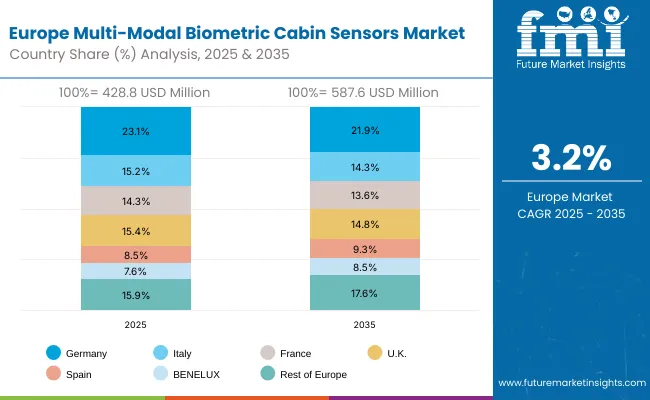
The multi-modal biometric cabin sensors market in Europe is projected to grow from USD 428.8 million in 2025 to USD 587.6 million by 2035, registering a CAGR of 3.2% over the forecast period. Germany is expected to maintain its leadership position with a 23.1% market share in 2025, declining slightly to 21.9% by 2035, supported by its advanced precision automotive sector and sensor technology manufacturing capabilities serving European and international markets.
The United Kingdom follows with a 15.9% share in 2025, projected to reach 17.6% by 2035, driven by established automotive expertise and security technology capabilities. France holds a 14.3% share in 2025, expected to reach 13.6% by 2035, supported by growing automotive innovation programs and sensor technology development. Italy commands a 15.2% share in 2025, projected to reach 14.3% by 2035, while Spain accounts for 8.5% in 2025, expected to reach 8.3% by 2035.
BENELUX maintains a 7.6% share in 2025, growing to 8.5% by 2035. The Rest of Europe region, including Nordic countries, Eastern Europe, and other European nations, is anticipated to hold 15.4% in 2025, declining to 15.8% by 2035, attributed to mixed growth patterns with steady expansion in some Eastern European markets balanced by slower growth in smaller Western European countries implementing automotive modernization programs.
Automotive-Centric Adoption Defines Japan’s Market Structure In Japan, the biometric cabin sensors market is primarily driven by automotive applications (52.8% share in 2025), reflecting the country’s strong automotive manufacturing base and rapid adoption of advanced driver and passenger monitoring systems. Automotive OEMs deploy facial recognition and voice-based biometrics to enhance driver safety, reduce distraction, and support regulatory compliance for intelligent transport systems. Aviation security (28.4%) remains the second-largest segment, spurred by Japan’s emphasis on border control, identity verification, and airport modernization. Building automation accounts for 18.8%, primarily in high-security facilities, though adoption is slower compared to transport-led use cases.
Market Characteristics
Technology Manufacturers Anchor South Korea’s Market Ecosystem In South Korea, the biometric cabin sensors market is structured around technology manufacturers (48.5% share in 2025), which collaborate with automotive OEMs (31.2%) and security companies (14.8%) to deploy multi-modal biometric solutions. Local electronics and semiconductor giants play a central role by supplying embedded biometric hardware and software platforms tailored for both automotive and aviation environments.
Automotive integration focuses on driver monitoring, fatigue detection, and personalized infotainment access, while security firms deploy biometric authentication in airports and high-security buildings. Collaboration between global biometric leaders and Korean tech manufacturers accelerates innovation, but international players such as NEC, Thales, and IDEMIA retain strong influence through advanced algorithm development.
Channel Insights
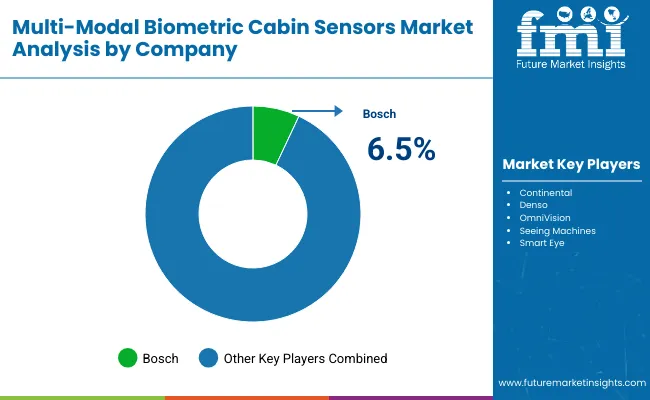
The multi-modal biometric cabin sensors market is characterized by competition among established sensor manufacturers, specialized biometric technology producers, and integrated automotive suppliers. Companies are investing in advanced sensor technologies, artificial intelligence systems, accuracy enhancement processes, and comprehensive validation protocols to deliver consistent, high-performance, and reliable biometric solutions. Innovation in sensor fusion, multi-modal authentication, and specialized automotive applications is central to strengthening market position and customer confidence.
Bosch leads the market with a strong focus on automotive sensor innovation and precision manufacturing, offering comprehensive sensor solutions that emphasize quality assurance and operational reliability with a 6.5% market share. Continental provides integrated automotive sensor and electronic component capabilities with a focus on advanced engineering and global automotive networks. Denso delivers specialized automotive sensor systems with a focus on vehicle excellence and automotive applications. OmniVision specializes in imaging sensor solutions with emphasis on optical technology and visual recognition applications. Seeing Machines focuses on driver monitoring technology and automotive safety applications. Smart Eye emphasizes eye tracking and driver attention monitoring with a focus on automotive safety integration.
The global multi-modal biometric cabin sensors market represents a critical technology segment within automotive safety and security authentication, projected to grow from USD 1,786.7 million in 2025 to USD 2,554.4 million by 2035 at a CAGR of 3.6%. Optical/Imaging sensors dominate with 35% market share, serving primarily automotive and security applications that demand exceptional authentication accuracy, operational reliability, and extended service capabilities.
The market's expansion is driven by automotive safety adoption, security requirement enhancement, and growing emphasis on multi-factor authentication across critical security applications. Achieving sustained growth requires coordinated efforts across automotive policy makers, security standards organizations, sensor manufacturers, system integrators, and investment providers.
Automotive Infrastructure Investment: Establish dedicated automotive technology zones and innovation hubs with specialized facilities for sensor development, including biometric testing centers, safety validation laboratories, and skilled workforce training institutes to support domestic automotive sensor capabilities.
R&D and Innovation Support: Fund research programs focused on advanced automotive sensors, AI integration with vehicle systems, and security authentication technologies. Support collaborative projects between universities, research institutes, and sensor manufacturers to develop next-generation automotive biometric solutions.
Skills Development Programs: Invest in technical education and vocational training programs that develop expertise in automotive electronics, biometric technology, sensor integration, and advanced manufacturing techniques required for automotive sensor production and deployment.
Regulatory Framework Development: Create comprehensive automotive standards for biometric sensors covering safety requirements, data privacy protocols, cybersecurity measures, and operational guidelines that ensure secure deployment while encouraging innovation in automotive biometrics.
Automotive Technology Adoption: Provide incentives for automotive manufacturers to adopt biometric solutions, establish pilot programs for sensor deployment, and create regulatory frameworks that support automotive safety technology investments.
Technical Standards Development: Establish comprehensive quality standards for automotive biometric sensors covering authentication accuracy, environmental durability, automotive compatibility, and performance criteria that ensure consistent quality across manufacturers and automotive applications.
Safety Certification Protocols: Develop standardized testing methodologies for automotive sensor evaluation including safety validation, authentication accuracy assessment, operational reliability testing, and automotive integration protocols that support procurement decisions.
Best Practices Documentation: Create technical guidelines for sensor deployment, authentication procedures, installation protocols, and maintenance methodologies that help automotive providers optimize sensor performance and ensure safety compliance across automotive applications.
Professional Certification Programs: Establish technical certification courses for automotive sensor specialists, integration engineers, and safety personnel to ensure industry-wide competency in automotive biometric technology and application expertise.
Market Intelligence & Analytics: Provide regular industry reports covering technology trends, automotive developments, competitive analysis, and emerging applications to guide strategic planning for manufacturers, integrators, and automotive providers across global markets.
Advanced Automotive Sensors: Develop precision automotive capabilities including multi-modal sensing systems, advanced authentication algorithms, environmental protection features, and automated safety protocols that ensure consistent performance meeting stringent automotive requirements.
AI Integration Capabilities: Incorporate machine learning, computer vision, and predictive analytics into sensor designs to enable intelligent authentication, adaptive security capabilities, and operational optimization for automotive system workflows.
Automotive Technology Innovation: Advanced automotive-specific features, including vibration resistance, temperature stability, automotive-grade components, and vehicle integration capabilities that improve operational effectiveness and ensure compliance with automotive standards.
Modular Automotive Platforms: Create standardized sensor families and modular automotive systems that enable rapid customization for specific vehicle applications while maintaining economies of scale and reducing development costs for specialized automotive requirements.
Technical Support Infrastructure: Establish comprehensive automotive support networks, including application engineering services, on-site technical assistance, training programs, and digital tools that help automotive providers deploy, integrate, and maintain optimal sensor solutions.
Integrated Design Strategies: Develop sensor integration approaches that optimize vehicle design around biometric capabilities, including user interface development, security protocol implementation, and privacy protection measures to maximize sensor effectiveness and vehicle safety.
Vendor Partnership Development: Build strategic relationships with sensor manufacturers that provide early access to automotive technologies, collaborative development opportunities, and guaranteed supply security for critical automotive applications requiring specialized sensor solutions.
Security System Integration: Implement biometric systems and security protocols that leverage automotive authentication to optimize vehicle access control, reduce security risks, and improve overall automotive safety while maintaining user convenience.
Application-Specific Solutions: Develop specialized sensor requirements for specific automotive applications including driver monitoring, passenger identification, vehicle access control, and fleet management that require unique performance characteristics and safety features.
Quality Assurance Programs: Establish comprehensive sensor validation procedures including automotive testing, safety verification, and supplier qualification processes that ensure consistent quality and performance across automotive sensor deployments.
Technology Development Funding: Finance advanced research facilities, sensor development systems, and automotive technology investments that enable sensor manufacturers to scale innovation capabilities and meet growing automotive demand for biometric solutions.
Automotive Innovation Capital: Provide venture capital and growth funding for automotive sensor startups developing AI-powered systems, advanced biometric sensors, innovative automotive applications, and digital solutions that advance sensor capabilities in vehicle environments.
Market Expansion Investment: Support automotive market development initiatives, including vehicle manufacturer partnerships, safety validation programs, regulatory approval processes, and automotive provider relationships in high-growth automotive markets.
Automotive Integration Support: Finance vertical integration strategies that combine sensor manufacturing with automotive technology development, vehicle component production, and integration support capabilities to create more comprehensive automotive biometric solutions.
Industry Consolidation Facilitation: Support strategic mergers and acquisitions that create larger, more capable automotive sensor organizations with enhanced automotive expertise, broader technology portfolios, and global automotive reach necessary to serve major vehicle manufacturers effectively.
| Items | Values |
|---|---|
| Quantitative Units (2025) | USD 1,786.7 Million |
| Measurement Principle | Optical/Imaging, Electromagnetic/Inductive, Acoustic/Ultrasonic, Other |
| Interface | Ethernet/Fieldbus, Serial/Discrete, I2C Line/Proprietary, Analog |
| Form Factor | Fixed, Portable, Embedded/Board-Level |
| End-Use Sector | Electronics/Semiconductor, F&B/Packaging, Industrial Process, Others |
| Regions Covered | North America, Europe, East Asia, South Asia & Pacific, Latin America, Middle East & Africa |
| Countries Covered | China, India, France, the United States, Germany, the United Kingdom, Japan and 40+ countries |
| Key Companies Profiled | Bosch, Continental, Denso, OmniVision, Seeing Machines, Smart Eye, Valeo, NXP Semiconductors, Infineon Technologies, STMicroelectronics, Magna International, Aptiv, Veoneer, ZF Friedrichshafen, Gentex Corporation |
| Additional Attributes | Dollar sales by measurement principle and end-use sector, regional demand trends, competitive landscape, technological advancements in sensor design, multi-modal integration capabilities, automotive safety programs, and biometric authentication strategies |
By North America
By Europe
By East Asia
By South Asia & Pacific
By Latin America
By Middle East & Africa
The market will expand from USD 1,786.7 million in 2025 to USD 2,554.4 million by 2035, growing at a CAGR of 3.6%.
The Optical/Imaging segment dominates with a 35.0% share in 2025, widely used for facial recognition and high-resolution biometric applications.
Growth is supported by rising demand for advanced security, regulatory compliance in vehicles, and the integration of AI-driven biometric technologies.
China (4.5% CAGR) and India (4.2% CAGR) are the fastest-growing markets, driven by rapid digitalization, automotive expansion, and security system adoption.






Our Research Products

The "Full Research Suite" delivers actionable market intel, deep dives on markets or technologies, so clients act faster, cut risk, and unlock growth.

The Leaderboard benchmarks and ranks top vendors, classifying them as Established Leaders, Leading Challengers, or Disruptors & Challengers.

Locates where complements amplify value and substitutes erode it, forecasting net impact by horizon

We deliver granular, decision-grade intel: market sizing, 5-year forecasts, pricing, adoption, usage, revenue, and operational KPIs—plus competitor tracking, regulation, and value chains—across 60 countries broadly.

Spot the shifts before they hit your P&L. We track inflection points, adoption curves, pricing moves, and ecosystem plays to show where demand is heading, why it is changing, and what to do next across high-growth markets and disruptive tech

Real-time reads of user behavior. We track shifting priorities, perceptions of today’s and next-gen services, and provider experience, then pace how fast tech moves from trial to adoption, blending buyer, consumer, and channel inputs with social signals (#WhySwitch, #UX).

Partner with our analyst team to build a custom report designed around your business priorities. From analysing market trends to assessing competitors or crafting bespoke datasets, we tailor insights to your needs.
Supplier Intelligence
Discovery & Profiling
Capacity & Footprint
Performance & Risk
Compliance & Governance
Commercial Readiness
Who Supplies Whom
Scorecards & Shortlists
Playbooks & Docs
Category Intelligence
Definition & Scope
Demand & Use Cases
Cost Drivers
Market Structure
Supply Chain Map
Trade & Policy
Operating Norms
Deliverables
Buyer Intelligence
Account Basics
Spend & Scope
Procurement Model
Vendor Requirements
Terms & Policies
Entry Strategy
Pain Points & Triggers
Outputs
Pricing Analysis
Benchmarks
Trends
Should-Cost
Indexation
Landed Cost
Commercial Terms
Deliverables
Brand Analysis
Positioning & Value Prop
Share & Presence
Customer Evidence
Go-to-Market
Digital & Reputation
Compliance & Trust
KPIs & Gaps
Outputs
Full Research Suite comprises of:
Market outlook & trends analysis
Interviews & case studies
Strategic recommendations
Vendor profiles & capabilities analysis
5-year forecasts
8 regions and 60+ country-level data splits
Market segment data splits
12 months of continuous data updates
DELIVERED AS:
PDF EXCEL ONLINE
Biometric Vehicle Access Market Size and Share Forecast Outlook 2025 to 2035
Biometric Payment Cards Market Size and Share Forecast Outlook 2025 to 2035
Biometric PoS Terminals Market by Technology, End-Use, and Region - Growth, Trends, and Forecast through 2025 to 2035
Biometric Driver Identification System Market Growth - Trends & Forecast 2025 to 2035
Biometric-as-a-Service Market Forecast 2025 to 2035
Biometric Lockers Market
Biometric Sensors Market Trends – Growth & Forecast 2025 to 2035
Military Biometrics Market Size and Share Forecast Outlook 2025 to 2035
Behavioral Biometrics Market Size and Share Forecast Outlook 2025 to 2035
Healthcare Biometrics Market Trends - Growth, Demand & Forecast 2025 to 2035
AI-enabled Biometrics Market
Contactless Biometric Technology Market by Technology, Component, Application & Region Forecast till 2035
Fingerprint Biometrics Market by Authentication Type, Mobility, Industry & Region Forecast till 2035
Hand Geometry Biometrics Market Insights - Trends & Growth 2025 to 2035
Device-Embedded Biometric Authentication Market Size and Share Forecast Outlook 2025 to 2035
Automotive Multimodal Interaction Development Market Size and Share Forecast Outlook 2025 to 2035
Multimodal Chromatography Columns Market
Sensors Market Analysis by Type, Technology, End User & Region - Forecast from 2025 to 2035
Biosensors Market Trends – Growth & Future Outlook 2025 to 2035
UV Sensors Market Analysis by Type, End User, and Region from 2025 to 2035

Thank you!
You will receive an email from our Business Development Manager. Please be sure to check your SPAM/JUNK folder too.
Chat With
MaRIA